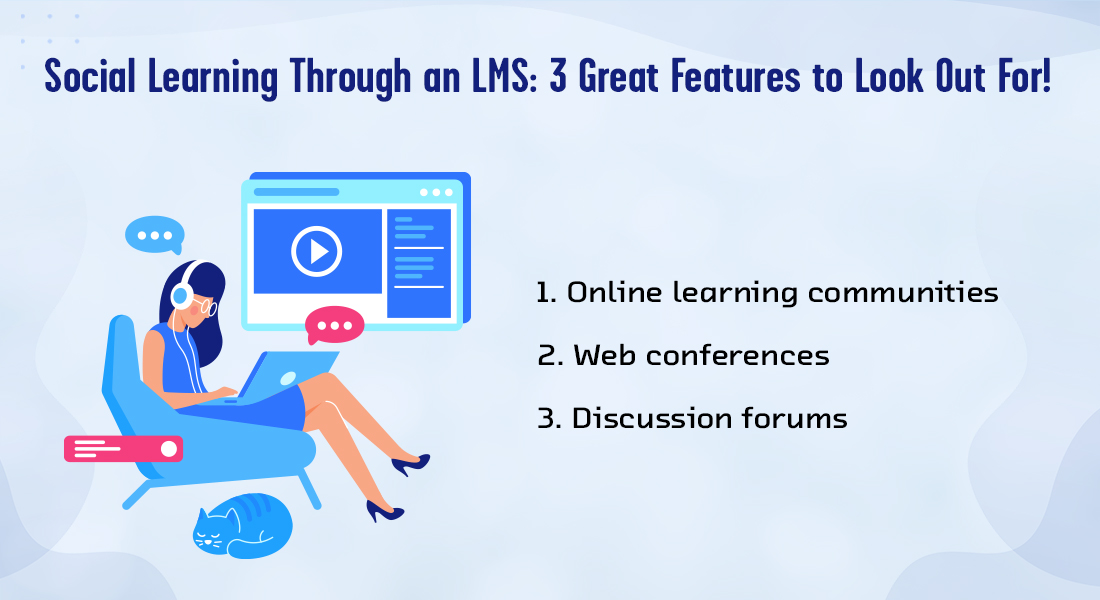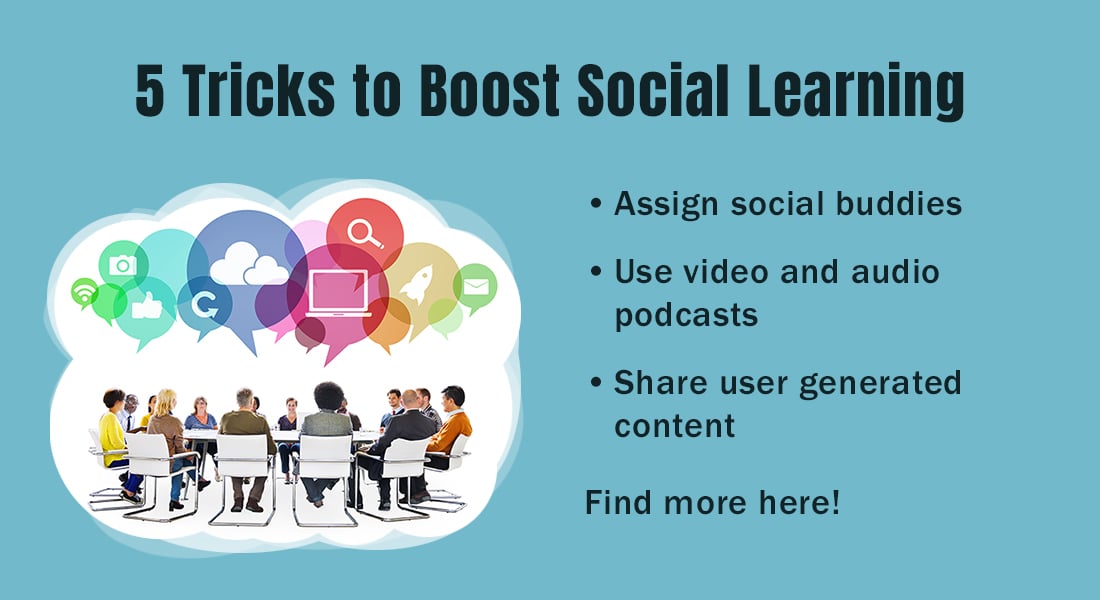How to Incorporate Social Learning in eLearning?

The social learning platform is catching the fancy of training industry. Do you think the same? To clear the air, humans have been learning socially since ages and faring well at it. However, this fact was unaware to us until Albert Bandura’s Social Learning Theory came to light.
→ Download Now: Instructional Design Strategies to Design Engaging eLearning Courses
4 Ways to Incorporate Social Learning in eLearning
- Foster observation and learning via online social learning
- Provide scope to interact and express through discussion forums
- Increase motivation through gamification
- Take social learning one step further with Q&A sessions
According to this theory, we tend to learn better when we observe and imitate somebody else’s actions and behavior – just like we admire the actions of our role models and try to emulate them. Similarly, some might follow photography and art sites to learn the tricks of photography; some might follow their favorite writers’ blogs to learn new ways of creative writing and so on. Every day, we learn something socially!
Are you wondering if social learning for training is another fad that will fade into darkness eventually? However, the numbers have a different story to convey.
What do Statistics Say?
- 85% of the surveyed organizations said they are using social and collaborative learning strategies. (Brandon Hall Group)
- A research at Stanford revealed that as much as 45% of their physicians benefited greatly from social learning. Doctors exchanged app as a patient-care related photos and messages, much like a study aid. (Stanford Medicine)
What are the Characteristics of Social Learning?
To put it simply, social learning is learning with others and from others. Learning can happen either by observing others’ behavior or by observing the consequences of the behavior.
- Learning can be through direct or indirect interactions. Direct includes face-to-face interactions in a formal training session or an informal on-the-job setting. Indirect includes using online discussion forums, social media handles, etc.
- Learners do not acquire information passively. Environment, cognition, and behavior influence each other, mutually.
How to Incorporate Social Learning in Online Learning?
Social learning doesn’t necessarily have to happen face-to-face. You can incorporate social learning elements in online learning as well. For instance, just like the interactions in a live classroom, the same can be emulated in online learning using social learning approaches via video conferencing tools. Let’s see some more strategies:

Instructional Design Strategies to Design Engaging eLearning Courses
Design Learner-Centric eLearning
- Importance of ID Strategies in eLearning
- Parameters to Select the Right ID Strategy
- ID Strategies for Effective Results
- Case Studies
1. Foster Observation and Learning
Adult learners will be more comfortable when the learning approach allows them to watch and learn. This allows them to share lessons, experiences, novel and creative ideas, probable solutions to their issues etc., – increasing the spectrum of their knowledge base.
To affirm this, the 70/20/10 model of learning and development shows that 70% learning happens through on-the-job experiences. 20% is acquired by social interactions, and 10% from formal learning.
How to achieve this in eLearning? Utilizing user-generated content such as videos in your online learning framework can help you leverage the benefits of social learning. It enables knowledge to be shared among your employees quickly and easily. Employees can record their own videos to share problems, best practices to tackle them, tips for better performance, and more. These videos can be uploaded in the learning portal of your organization and used when needed.
For instance, sales representatives can record a video of them sharing newly learned tactics and information that can be used by their colleagues before a sales call or a client meet. Or employees can record a video of how to handle machinery and share it with new hires to familiarize them with the technology. Irrespective how you use videos, they are an invaluable social learning tool that enables your employees to stay updated with the latest information.
2. Provide Scope to Interact and Express through Discussion Forums
If you thought it’s easier for learners to interact and express in a classroom setting, then it’s time to reconsider. With advancement in technology, there are several ways you can enable and encourage learners to interact and foster knowledge sharing in an online setting.
The online discussion functionality in the LMS allows learners to log in, observe, and participate in a discussion. This can be about anything from troubleshooting steps to the features of a new product, emerging market trends, and more. Online discussion forums allow your learners to find answers to their questions from those who know.
Similarly, you can create a discussion forum online for any work-related topics you want your learners to indulge in. You can even provide online chat groups to learners for discussing topics or concepts that weren’t covered in-depth in formal training. Additionally, you can even utilize this method prior to formal training. Inviting learners to a related discussion can help you and your learners evaluate their knowledge gap.
3. Increase Motivation in Social Learning through Gamification
We all know adult learners tend to learn better when they are motivated. According to the Social Learning Theory, motivation originates from being rewarded or even punished. And consequently, in a similar situation, learners will either try to imitate or avoid actions based on their past experiences.
How do you do that in eLearning? Leveraging the gamification principles in the learning framework is a great way to motivate through rewards. After all, who doesn’t like to play a good a game and win? This trait can be utilized to boost social interactions in your eLearning programs. Gaming elements such as badges, points, and scoreboards can be incorporated within the learning content.
For instance, your eLearning program can be created to have leaderboards with a point system. You can even announce a weekly winner with the highest number of points to motivate further. These gaming elements possess the potential to keep your learners hooked. Learners can also be given a personalized certificate of achievement upon successful completion or as a reward. They will be invested and engaged throughout the eLearning course, and have healthy competition with their colleagues to top the leaderboard.
4. Take Social Learning One Step Further with Q&A Sessions
Q&A sessions are interactive in nature and hence more popular with learners. It is also one of the most-used online social learning strategies. Most Learning Management Systems (LMS) allow the easy inclusion of Q&A sessions.
This feature allows your learners to ask their questions and get clarifications from Subject Matter Experts or experts from their department in an organized manner. Additionally, you can also compile these questions and answers and disseminate them as an online PDF.
I’m sure by now you have realized the benefits associated with social learning. Considering the importance of engagement in online learning, leveraging the right social learning strategy will lead to effective learning and hence better retention and recall. Hence, incorporate these strategies in your corporate training and fill the training gaps you may have in your eLearning curriculum.
Have something to share? We would love to hear your thoughts about this blog. Do feed in your comments in the section below.





